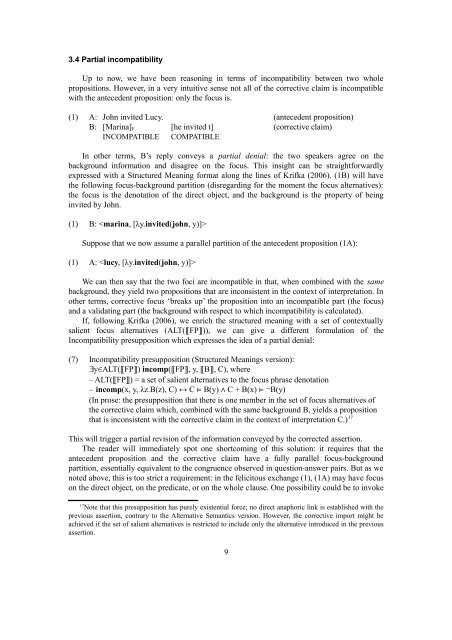Empirical Issues in Syntax and Semantics 9 (EISS 9 ... - CSSP - CNRS
Empirical Issues in Syntax and Semantics 9 (EISS 9 ... - CSSP - CNRS
Empirical Issues in Syntax and Semantics 9 (EISS 9 ... - CSSP - CNRS
You also want an ePaper? Increase the reach of your titles
YUMPU automatically turns print PDFs into web optimized ePapers that Google loves.
3.4 Partial <strong>in</strong>compatibility<br />
Up to now, we have been reason<strong>in</strong>g <strong>in</strong> terms of <strong>in</strong>compatibility between two whole<br />
propositions. However, <strong>in</strong> a very <strong>in</strong>tuitive sense not all of the corrective claim is <strong>in</strong>compatible<br />
with the antecedent proposition: only the focus is.<br />
(1) A: John <strong>in</strong>vited Lucy. (antecedent proposition)<br />
B: [Mar<strong>in</strong>a] F [he <strong>in</strong>vited t] (corrective claim)<br />
INCOMPATIBLE COMPATIBLE<br />
In other terms, B’s reply conveys a partial denial: the two speakers agree on the<br />
background <strong>in</strong>formation <strong>and</strong> disagree on the focus. This <strong>in</strong>sight can be straightforwardly<br />
expressed with a Structured Mean<strong>in</strong>g format along the l<strong>in</strong>es of Krifka (2006). (1B) will have<br />
the follow<strong>in</strong>g focus-background partition (disregard<strong>in</strong>g for the moment the focus alternatives):<br />
the focus is the denotation of the direct object, <strong>and</strong> the background is the property of be<strong>in</strong>g<br />
<strong>in</strong>vited by John.<br />
(1) B: <br />
Suppose that we now assume a parallel partition of the antecedent proposition (1A):<br />
(1) A: <br />
We can then say that the two foci are <strong>in</strong>compatible <strong>in</strong> that, when comb<strong>in</strong>ed with the same<br />
background, they yield two propositions that are <strong>in</strong>consistent <strong>in</strong> the context of <strong>in</strong>terpretation. In<br />
other terms, corrective focus ‘breaks up’ the proposition <strong>in</strong>to an <strong>in</strong>compatible part (the focus)<br />
<strong>and</strong> a validat<strong>in</strong>g part (the background with respect to which <strong>in</strong>compatibility is calculated).<br />
If, follow<strong>in</strong>g Krifka (2006), we enrich the structured mean<strong>in</strong>g with a set of contextually<br />
salient focus alternatives (ALT([[FP]])), we can give a different formulation of the<br />
Incompatibility presupposition which expresses the idea of a partial denial:<br />
(7) Incompatibility presupposition (Structured Mean<strong>in</strong>gs version):<br />
∃y∈ALT([[FP]]) <strong>in</strong>comp([[FP]], y, [[B]], C), where<br />
– ALT([[FP]]) = a set of salient alternatives to the focus phrase denotation<br />
– <strong>in</strong>comp(x, y, λz.B(z), C) ↔ C ⊨ B(y) ∧ C + B(x) ⊨ ¬B(y)<br />
(In prose: the presupposition that there is one member <strong>in</strong> the set of focus alternatives of<br />
the corrective claim which, comb<strong>in</strong>ed with the same background B, yields a proposition<br />
that is <strong>in</strong>consistent with the corrective claim <strong>in</strong> the context of <strong>in</strong>terpretation C.) 17<br />
This will trigger a partial revision of the <strong>in</strong>formation conveyed by the corrected assertion.<br />
The reader will immediately spot one shortcom<strong>in</strong>g of this solution: it requires that the<br />
antecedent proposition <strong>and</strong> the corrective claim have a fully parallel focus-background<br />
partition, essentially equivalent to the congruence observed <strong>in</strong> question-answer pairs. But as we<br />
noted above, this is too strict a requirement: <strong>in</strong> the felicitous exchange (1), (1A) may have focus<br />
on the direct object, on the predicate, or on the whole clause. One possibility could be to <strong>in</strong>voke<br />
17<br />
Note that this presupposition has purely existential force; no direct anaphoric l<strong>in</strong>k is established with the<br />
previous assertion, contrary to the Alternative <strong>Semantics</strong> version. However, the corrective import might be<br />
achieved if the set of salient alternatives is restricted to <strong>in</strong>clude only the alternative <strong>in</strong>troduced <strong>in</strong> the previous<br />
assertion.<br />
9











